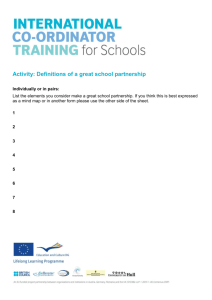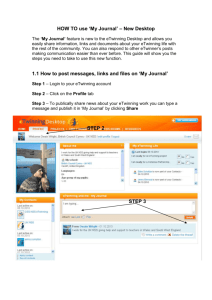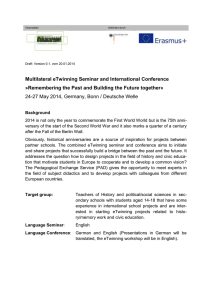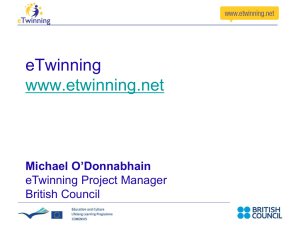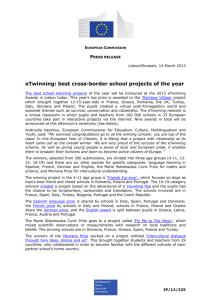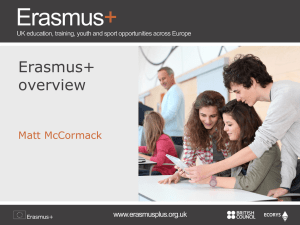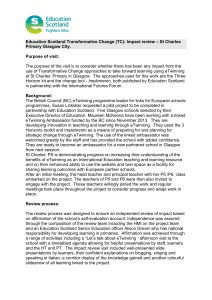Report on Cowcaddens Nursery eTwinning Project
advertisement
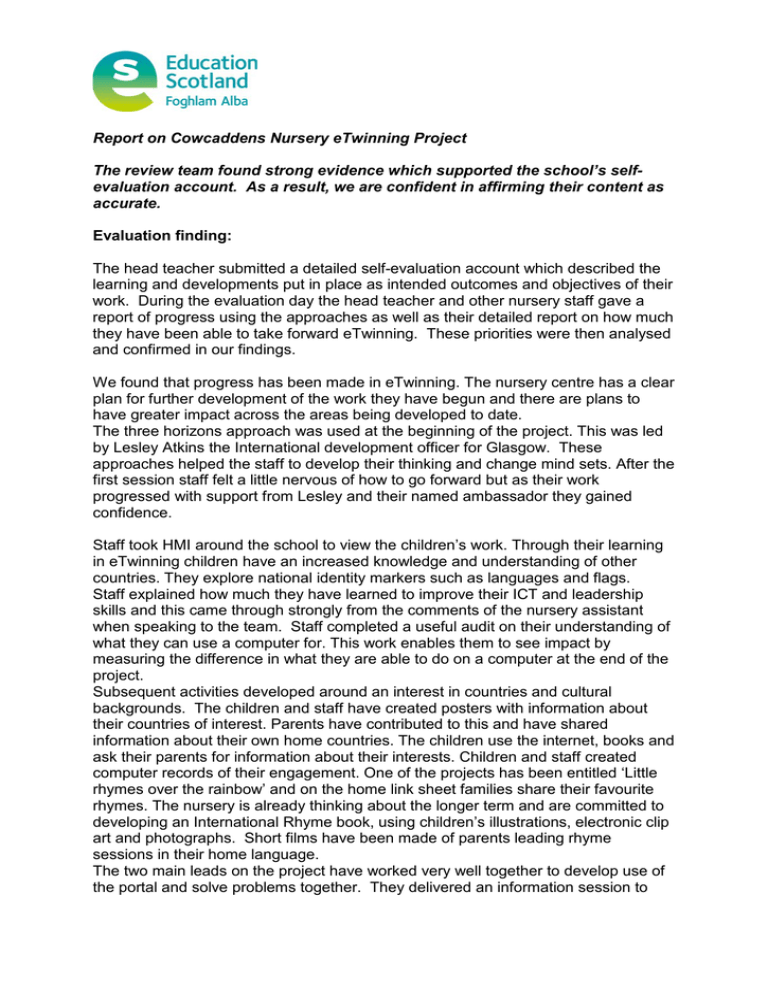
Report on Cowcaddens Nursery eTwinning Project The review team found strong evidence which supported the school’s selfevaluation account. As a result, we are confident in affirming their content as accurate. Evaluation finding: The head teacher submitted a detailed self-evaluation account which described the learning and developments put in place as intended outcomes and objectives of their work. During the evaluation day the head teacher and other nursery staff gave a report of progress using the approaches as well as their detailed report on how much they have been able to take forward eTwinning. These priorities were then analysed and confirmed in our findings. We found that progress has been made in eTwinning. The nursery centre has a clear plan for further development of the work they have begun and there are plans to have greater impact across the areas being developed to date. The three horizons approach was used at the beginning of the project. This was led by Lesley Atkins the International development officer for Glasgow. These approaches helped the staff to develop their thinking and change mind sets. After the first session staff felt a little nervous of how to go forward but as their work progressed with support from Lesley and their named ambassador they gained confidence. Staff took HMI around the school to view the children’s work. Through their learning in eTwinning children have an increased knowledge and understanding of other countries. They explore national identity markers such as languages and flags. Staff explained how much they have learned to improve their ICT and leadership skills and this came through strongly from the comments of the nursery assistant when speaking to the team. Staff completed a useful audit on their understanding of what they can use a computer for. This work enables them to see impact by measuring the difference in what they are able to do on a computer at the end of the project. Subsequent activities developed around an interest in countries and cultural backgrounds. The children and staff have created posters with information about their countries of interest. Parents have contributed to this and have shared information about their own home countries. The children use the internet, books and ask their parents for information about their interests. Children and staff created computer records of their engagement. One of the projects has been entitled ‘Little rhymes over the rainbow’ and on the home link sheet families share their favourite rhymes. The nursery is already thinking about the longer term and are committed to developing an International Rhyme book, using children’s illustrations, electronic clip art and photographs. Short films have been made of parents leading rhyme sessions in their home language. The two main leads on the project have worked very well together to develop use of the portal and solve problems together. They delivered an information session to colleagues and during our evaluation meeting showed a strong interest in the work they have completed and in taking things forward next session. Staff increased their skills using eTwinning through a visit from a primary head taking part in the pilot. All stakeholders share the staff’s view that the eTwinning work beginning with the transformative change approaches, has been a key driver in taking forward distributed leadership across the centre. There is a positive impact on learning in the playrooms and on the life and ethos of the nursery and community. Areas for development: During the pilot a number of issues surfaced around the use of the ICT to support the eTwinning portal. Lesley Atkins the International Development Officer has prepared a paper to be taken back to the British Council for action to remedy these issues. HMI will be keen to see the issues listed ameliorated by the lead team in Brussels to provide learners and their teachers the best possible ICT platform for learning. 2. Impact on all stakeholders: raising ambition and expectations for change. To share and record this work widely for others, the children at Cowcaddens nursery have contributed to a big book and posters recording all the information they have learned. They used mind maps and developed enquiry skills such as questioning and research to get information needed. Staff have shared with each other how their skills in ICT and higher order thinking skills are developing through the work of the project. Staff and children can now understand and use a blog. We found that staff are becoming much more interested in learning through their work in eTwinning. Children’s vocabulary has increased through this project and they are able to take responsibility for choosing what is to be added onto the twin-space. They are keen to develop across different subject areas and this was exemplified in the big books showing for example aspects of learning in literacy, geography and art and design. Through having a partner school in a French village, children now understand differences between living in a village from living in a big city. They learned that songs sung by the French children can be the same as in Glasgow but with different words. The link to the Polish centre is developing ideas for future learning possibly based around both nurseries being near a botanic garden. Staff showed they realised that when leading learning, it is important to follow authority policies. For example they understood the need to keep parents informed and sent out a letter assuring them about the secure nature of a twin space. They also checked that parents speaking a different language had been able to find help with translation of the letter. The use of eTwinning is allowing staff and children to share ideas and validate their own varied backgrounds. This nursery has 12 nationalities. 3. Impact on learners: improving skills for learning, life and work The children’s knowledge of the use of ICT has increased through learning about eTwinning. As a result of their work, children have an awareness now of how information can be shared through the twin space. They are developing film making skills and how to be a good listener when watching their completed work. They have been introduced to email for sending messages. Through this work children are developing an awareness of a wider world around them and are exploring similarities and differences in lifestyles and childhoods such as rhymes, clothing and language. This was exemplified well through the displays and in the big book of examples which they put together on the project. The children have led parts of the project by suggesting some of the countries to be investigated. Staff participants have led the project and this has led to increased confidence for them as well as the learners. Parents have shared information about how to say hello and goodbye in home languages and this has created opportunities for further partnerships in the future. The project is linked to wellbeing indicators of GIRFEC; pupil voice has led the development of the international learning, the children’s cultural backgrounds are respected, partnerships between children, staff and parents have developed. 4. Impact on leaders: empowering, facilitating and equipping leaders at all levels. Through HMI questioning and from staff comments we can see that staff leadership has improved in the context of the project and this will continue next session. The lead team has been instrumental in making sure that things happen and have used their initiative. Being part of the project has brought the International Education agenda into the fore and children are developing an awareness of the wider world. Parental partnership will continue to be strengthened next session and they will be part of developments taken forward using eTwinning. 5. Conclusion At the beginning of this partnership between the British Council and Education Scotland, staff were feeling unsure about whether they were able to complete the task. They used the transformative change approaches to open their ideas to learning fit for the 21st century and then began to consider their big action point of embedding eTwinning across learning to widen the children’s knowledge and understanding of their world and to help them learn and understand different cultures in a nursery with a lot of different nationalities. The two approaches (three horizon and implemento) were used by staff and they are now proud of the changes they have led to improve learning for all the children in the nursery. These changes include better use of ICT, the development of e-twinning to effect positive curriculum developments and better linking with parents on the theme of the value of global learning through eTwinning. The next steps are to continue with plans to build on the successful partnerships being built this session. In particular the very successful work achieved through eTwinning. The nursery should also now use the knowledge gained from the work to date to impact positively on all learning, teaching and curriculum development across the centre. Staff demonstrate an increasing confidence and a desire to take forward leadership. Staff are ready to demonstrate the use of transformative change approaches and eTwinning for new partners participating in eTwinning within their authority. We will look forward to hearing about their continuing developments and their future success with this ongoing work. Team comments on the report: Mary Ann Hagan HMI reviewed, commented and edited the report and concurs with its findings. Aileen Monaghan HMI
